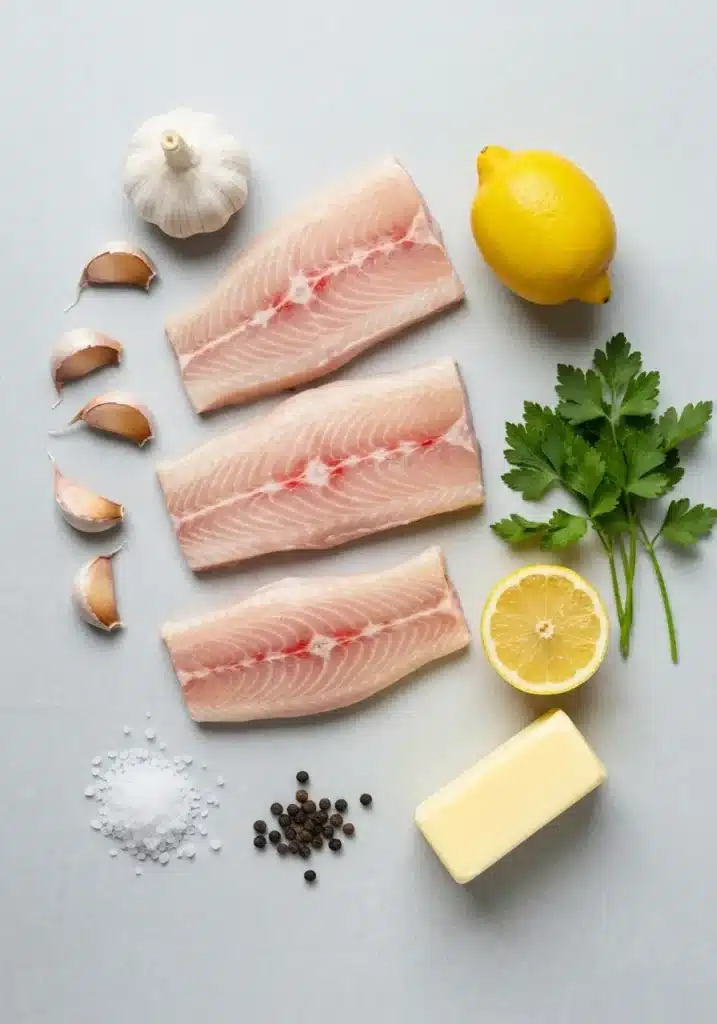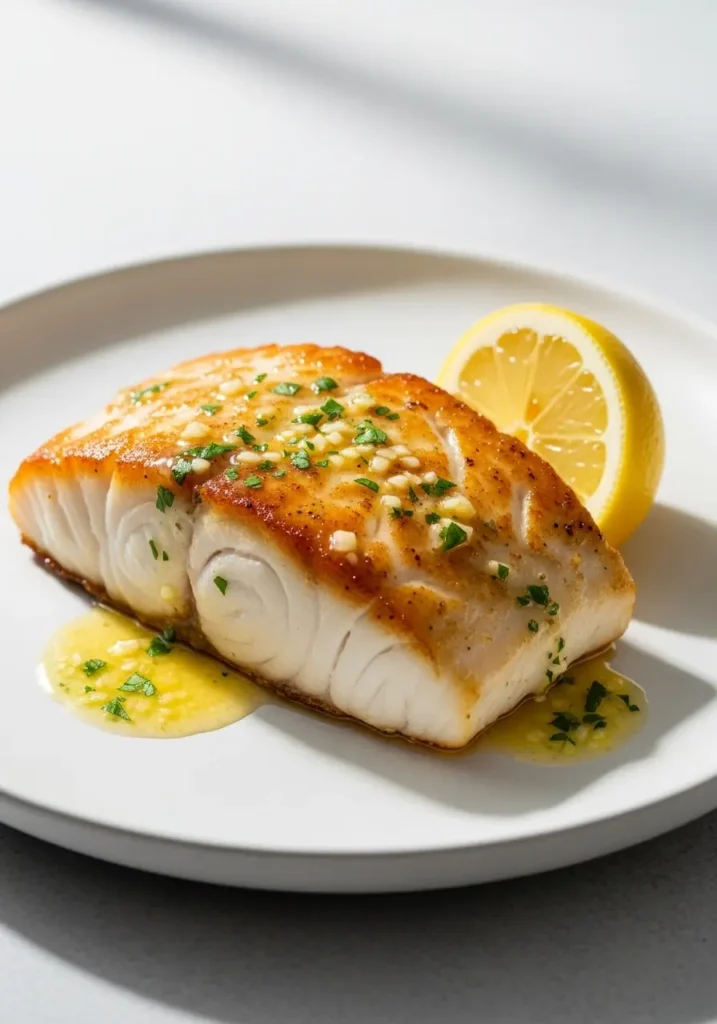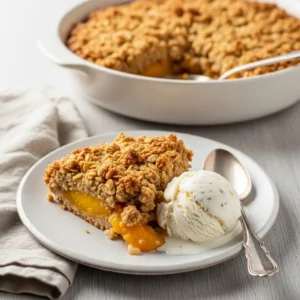This truly is the best halibut recipe for a reason. It delivers a restaurant-quality meal in under 20 minutes with just a handful of simple ingredients. We’re talking a perfectly golden, crispy crust giving way to an incredibly moist, flaky interior, all bathed in a luscious lemon garlic butter sauce. It’s the foolproof method you need for a quick weeknight dinner or an elegant meal to impress guests.
Forget dry, overcooked fish forever. The secret lies in a hot pan and a simple, classic flavor combination that enhances the halibut’s mild, sweet taste without overpowering it. This recipe is designed to be simple, reliable, and absolutely delicious every single time you make it.
Why This is the BEST Halibut Recipe
In a sea of fish recipes, this one stands out for its pure simplicity and spectacular results. Here’s why you’ll love it:
- Incredibly Fast: From prep to plate, this entire dish is ready in about 15 minutes, making it perfect for busy evenings.
- Simple Ingredients: You only need 5 core ingredients, most of which you probably have in your kitchen right now.
- Foolproof Technique: Pan-searing gives you maximum control, ensuring a perfect cook. We’ll share the exact tips to prevent the dreaded dry fish.
- Amazing Flavor and Texture: The combination of a crispy exterior, tender flakes, and a bright, savory pan sauce is simply unbeatable.
The 5 Simple Ingredients You’ll Need
High-quality fish shines with simple preparation. For this recipe, focus on fresh, quality ingredients for the best possible flavor.

- Halibut Fillets: Look for thick, firm fillets, about 1 to 1.5 inches thick. This thickness helps prevent overcooking. You can use skin-on or skinless.
- Unsalted Butter: This is the base of our luxurious pan sauce. Using unsalted butter lets you control the final saltiness of the dish.
- Garlic: Freshly minced garlic provides the best aromatic, savory flavor.
- Lemon: We’ll use both the juice and fresh slices for a bright, zesty kick that cuts through the richness of the butter.
- Fresh Parsley: Adds a pop of color and fresh, herbaceous flavor at the end.
You will also need olive oil (or another high-smoke point oil), salt, and freshly ground black pepper for the initial sear and seasoning.
How to Cook Halibut Perfectly: A Step-by-Step Guide
Follow these simple steps for a flawless finish. The key is to work quickly and not to overthink it!
Step 1: Prepare the Halibut
First, remove the halibut fillets from the refrigerator about 15-20 minutes before cooking to let them come to room temperature. This promotes even cooking. Pat the fillets completely dry with paper towels. A dry surface is absolutely essential for getting that beautiful golden-brown crust. Season both sides generously with salt and freshly ground black pepper.
Step 2: Sear for a Golden Crust
Place a large skillet (cast iron or stainless steel work best) over medium-high heat. Add a tablespoon of olive oil. Once the oil is shimmering hot, carefully place the halibut fillets in the pan, presentation-side down. Let them sear, undisturbed, for 3-4 minutes, until a deep golden crust forms on the bottom.
Step 3: Flip and Add Aromatics
Using a fish spatula, carefully flip the fillets. Immediately reduce the heat to medium-low. Add the unsalted butter and minced garlic to the pan. The butter will melt and foam, picking up all the delicious browned bits from the bottom of the pan.
Step 4: Create the Lemon Butter Pan Sauce
As the butter melts, tilt the pan slightly and use a spoon to baste the fish continuously with the garlic butter for about 2-3 minutes. This keeps the fish moist and infuses it with flavor. Squeeze the fresh lemon juice into the pan, add the chopped parsley, and give the pan a gentle swirl. The fish is done when it flakes easily with a fork or reaches an internal temperature of 130-135°F. Remove from heat immediately and serve with extra pan sauce drizzled over the top.

Expert Tips for Flaky, Never-Dry Halibut
- Use a Hot Pan: Don’t add the fish until your pan and oil are properly heated. This is the secret to a non-stick sear and a great crust.
- Don’t Crowd the Pan: Cook in batches if necessary. Overcrowding the skillet will steam the fish instead of searing it.
- Know When It’s Done: Halibut cooks quickly! The best way to check for doneness is with an instant-read thermometer (130-135°F). If you don’t have one, test it with a fork; the flesh should be opaque and flake easily. Remove it from the heat just before you think it’s done, as it will continue to cook from residual heat.
- Let It Rest: Just like steak, letting the fish rest for a minute or two before serving allows the juices to redistribute, ensuring a moist fillet.
Serving Suggestions: What Goes Well with Halibut?
This simple halibut dish pairs beautifully with a wide variety of sides. Keep it simple to let the fish be the star.
- Vegetables: Roasted asparagus, steamed green beans, or sautéed spinach.
- Starches: Creamy risotto, quinoa, rice pilaf, or simple roasted potatoes.
- Salad: A simple green salad with a light vinaigrette.
Variations and Substitutions
While this recipe is perfect as is, you can easily adapt it to your taste. For another amazing flavor profile, try this incredible restaurant-quality miso halibut recipe (coming soon).
| Ingredient | Substitution Suggestion |
|---|---|
| Herbs | Fresh dill, chives, or thyme can be used instead of or in addition to parsley. |
| Butter | For a richer, nuttier flavor, allow the butter to brown slightly before adding the garlic. |
| Add-ins | A splash of dry white wine (like Pinot Grigio) can be added with the lemon juice to deglaze the pan. A tablespoon of capers also adds a lovely briny kick. |
Prefer to Bake It? An Easy Oven Method
If you prefer baking, this recipe is easily adaptable. While our favorite way to get a perfect crust is with this method, you can find a fully detailed guide in our simple and easy baked halibut recipe. To adapt this specific recipe, preheat your oven to 400°F (200°C). Place the seasoned halibut in a baking dish. Melt the butter with the garlic, then pour it over the fillets. Top with lemon slices. Bake for 10-14 minutes, depending on thickness, until the fish is flaky and cooked through.

Best Halibut Recipe (Perfectly Pan-Seared in 15 Minutes!)
This is the best halibut recipe for perfectly flaky, moist fish every time. Pan-seared to create a golden crust and finished with a luscious lemon garlic butter sauce, this simple and healthy dinner is ready in under 20 minutes.
Ingredients
Equipment
Instructions
- Pat the halibut fillets completely dry with paper towels. A dry surface is crucial for a good sear. Season both sides generously with salt and pepper.
- Heat olive oil in a large skillet over medium-high heat. Once the oil is shimmering, carefully place the halibut fillets in the pan. Sear for 3-4 minutes without moving them, until a golden-brown crust forms.
- Flip the fillets. Reduce heat to medium-low and add the butter and minced garlic to the skillet.
- As the butter melts, tilt the pan and use a spoon to baste the fish with the garlic butter for 2-3 minutes, until the fish is cooked through and flakes easily with a fork (internal temperature should be 130-135°F).
- Remove the skillet from the heat. Squeeze in the fresh lemon juice and stir in the chopped parsley. Serve immediately, spooning the extra pan sauce over the fillets.
Notes
Tip 1: Don't Overcook! Halibut goes from perfect to dry very quickly. Remove it from the heat when it's just about done; it will continue to cook for a minute off the heat.
Tip 2: Dry Fish is Key. The drier the surface of your fish, the better the sear you will achieve. Don't skip the step of patting it thoroughly with paper towels.
Tip 3: Use a Thermometer. The most reliable way to check for doneness is with an instant-read thermometer. Aim for 130-135°F in the thickest part.

Best Halibut Recipe (Perfectly Pan-Seared in 15 Minutes!)
Ingredients
Equipment
Instructions
- Pat the halibut fillets completely dry with paper towels. A dry surface is crucial for a good sear. Season both sides generously with salt and pepper.
- Heat olive oil in a large skillet over medium-high heat. Once the oil is shimmering, carefully place the halibut fillets in the pan. Sear for 3-4 minutes without moving them, until a golden-brown crust forms.
- Flip the fillets. Reduce heat to medium-low and add the butter and minced garlic to the skillet.
- As the butter melts, tilt the pan and use a spoon to baste the fish with the garlic butter for 2-3 minutes, until the fish is cooked through and flakes easily with a fork (internal temperature should be 130-135°F).
- Remove the skillet from the heat. Squeeze in the fresh lemon juice and stir in the chopped parsley. Serve immediately, spooning the extra pan sauce over the fillets.
Notes
Tip 2: Dry Fish is Key. The drier the surface of your fish, the better the sear you will achieve. Don't skip the step of patting it thoroughly with paper towels.
Tip 3: Use a Thermometer. The most reliable way to check for doneness is with an instant-read thermometer. Aim for 130-135°F in the thickest part.
Frequently Asked Questions About The Best Halibut Recipe
While butter provides the best flavor for the classic sauce, you can substitute it with a high-quality olive oil or ghee. For a dairy-free option, use a good vegan butter substitute.
Halibut is done when its internal temperature reaches 130-135°F (54-57°C) on an instant-read thermometer. If you don’t have one, check if the flesh has turned from translucent to opaque and flakes easily with a fork. Be careful not to overcook it!
You can do either! Cooking with the skin on (sear the skin side last) can help hold the fillet together and keep it moist. The skin becomes crispy and is delicious to eat. If you prefer no skin, it’s perfectly fine to use skinless fillets.
A heavy-bottomed skillet like cast iron or stainless steel is best for searing. These pans retain heat exceptionally well, which is crucial for creating a beautiful, golden-brown crust without overcooking the inside of the fish.
The best way to thaw frozen halibut is to place it in the refrigerator overnight. For a quicker method, place the vacuum-sealed fish in a bowl of cold water for about 30-60 minutes, changing the water occasionally until it’s thawed.
Storing and Reheating Leftovers
Store leftover halibut in an airtight container in the refrigerator for up to 2 days. To reheat, warm it gently in a skillet over low heat with a splash of water or broth, or in a low-temperature oven (300°F) until just warmed through. Avoid the microwave, as it can make the fish rubbery.
More Delicious Fish Recipes To Try
If you loved this simple halibut recipe, you’ll be thrilled to know that a perfect crust is achievable with other methods, too. This easy pan seared halibut recipe dives even deeper into the technique. For a fantastic one-pan meal, check out our vibrant Mediterranean halibut recipe with olives and tomatoes.
We’re confident this will become your go-to method for cooking halibut! If you try it, please leave a comment below and let us know how it turned out. We’d also love for you to share it on Pinterest!



